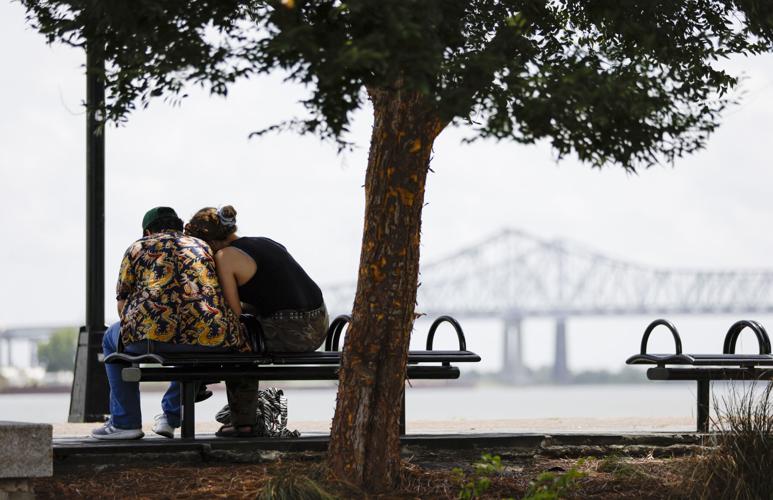Heat waves in major U.S. cities have severely worsened over the last six decades, a new study says — and New Orleans is sweating it out at the top of the list.
Using data from the 50 largest cities from 1961 to 2023, the Environmental Protection Agency study looks at four metrics of heat waves: frequency, duration, season length and intensity. The study is one section of a larger EPA report documenting the impacts of climate change on people and the environment, including new analyses of wildfire and coastal flooding.
“Heat waves are more than just uncomfortable: They can lead to illness or death, particularly among older adults, the very young, and other vulnerable populations,” the study reads.
Particularly hot days are part of a normal climate, but as the Earth warms, “hotter-than-usual days and nights are becoming more common and heat waves are expected to last longer and become more frequent and intense.”

Kisha Howard, left, Keith Barnhart, Amira Henry and Rashan Henry, all of the Wilmington, Delaware area, take in a cool breeze as they view the Mississippi River and the Crescent City Connection in New Orleans, Sunday, July 7, 2024. The foursome is in town for vacation and to attend Essence Festival events and concerts. The muggy heat continues, with rain chances rising Monday afternoon and continuing through Thursday. (Staff photo by Scott Threlkeld, The Times-Picayune)
Heat waves in New Orleans increased across all four measurements and led the country with the largest uptick in heat wave duration, beating Fort Worth, Texas, and Las Vegas. The city’s average heat wave last year was four and a half days longer than the average heat wave of 1961.
In addition to topping the list for duration, New Orleans also saw one of the nation’s largest increases in the number of heat waves and the length of heat wave seasons, defined as the amount of days between the first and last heat wave of the year.
Last year, New Orleans experienced nine more heat waves than it did in the 1960s, accounting for a heat wave season more than 100 days longer than the first year recorded in the study. Only San Juan, Puerto Rico; Miami; and Tampa, Florida, had greater changes to the number of annual heat waves.

While New Orleans endured some of the most extreme heat wave rises, national averages increased along all four metrics. According to the study, which uses data from the National Oceanic and Atmospheric Administration, 46 of the 50 cities saw a rise in the number of annual heat waves.
In the 1960s, major cities experienced an average of two annual heat waves, a figure that steadily increased to six in the 2010s and 2020s. Heat wave seasons are now around 46 days longer than they were in the 1960s, and half a degree hotter than average local temperatures.
The study defines heat waves as a period of two or more consecutive days when the daily minimum “feels like” temperatures are more than the 85th percentile of July and August temperatures for each city. These parameters translate to the hottest temperatures during the two hottest months of the year.
The report also mentions the “urban heat island” effect, where cities tend to have higher temperatures than rural areas due to a relative lack of trees and other plants. But the study does not distinguish between those effects and factors such as climate change, “because it focuses on the temperatures to which people are actually exposed.”
LSU climatologist Barry Keim said looking at minimum temperatures is “just as important as maximum temperatures.” High minimum temperatures, which typically occur at night, prevent the body from cooling off.
“This aspect of heat waves threatens vulnerable individuals in particular, by eroding the recovery period they need after daytime heat,” EPA spokesperson Shayla Powell said. “While EPA’s heat wave indicator doesn’t examine the different heat impacts in a given city, we know that not all individuals have the same vulnerability to heat impacts.”
Infants, older adults, pregnant women and people who work or exercise outside are some of the most susceptible to heat-related illnesses, such as heatstroke, heat cramps and exhaustion.

A cyclist pushes his double-decker bicycle on the Roosevelt Mall at City Park in New Orleans, Sunday, July 7, 2024. The muggy heat continues, with rain chances rising Monday afternoon and continuing through Thursday. (Staff photo by Scott Threlkeld, The Times-Picayune)
Last year was the hottest year on record for New Orleans, when the city tied for the second-longest streak of extreme heat in the world, according to one study. Across the state, Louisianans suffered from these record-breaking conditions. Last year, there were 88 heat-related deaths in Louisiana and over 6,000 heat-related emergency department visits, according to the state health department.
In humid climates like New Orleans, LSU researcher Derek Thomspon explained, sweat evaporates off the body at slower rates and prolongs the health risks of the heat. The EPA study accounts for these disparities, using heat index “feels like” temperatures in their analysis.
The intensification and rising frequency of heat waves, alongside the warming temperatures of the Gulf of Mexico and increasing humidity levels, creates a situation “more and more difficult to air condition yourself out of,” Keim said.
While this year’s forecast is not expected to be as extreme as last year, the city issued excessive heat warnings for “feels like” temperatures reaching 118 degrees earlier this month, and designated libraries and other spaces as cooling centers for residents.
And according to city officials, emergency heat-related illness calls are already breaking records.






